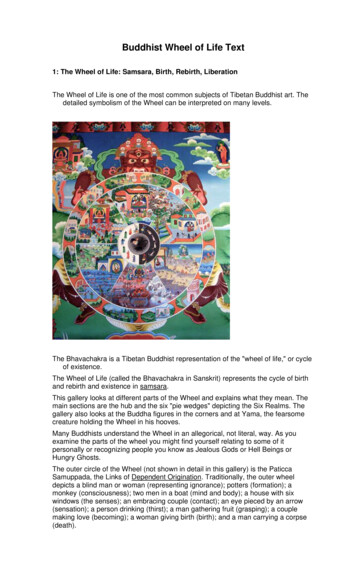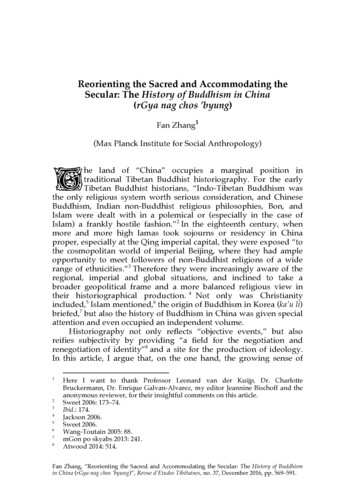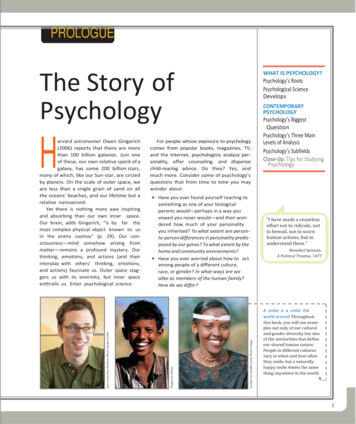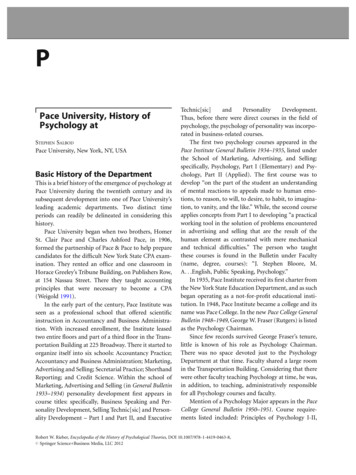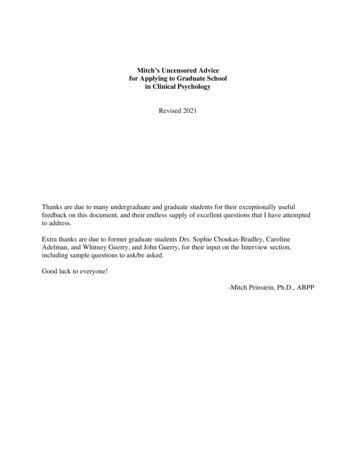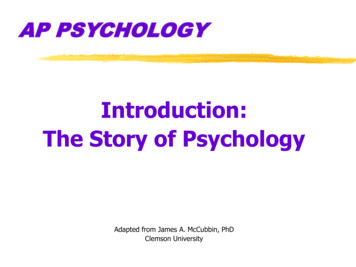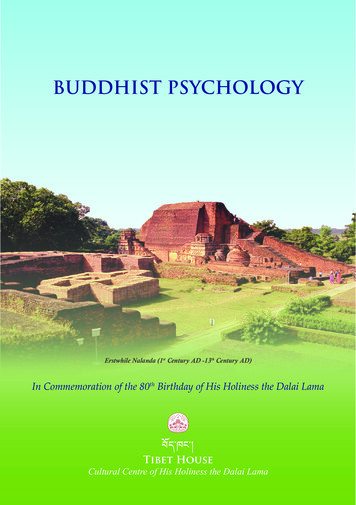
Transcription
BUDDHIST PSYCHOLOGYErstwhile Nalanda (1st Century AD -13th Century AD)In Commemoration of the 80th Birthday of His Holiness the Dalai Lamaབོད་ཁང་།Tibet HouseCultural Centre of His Holiness the Dalai Lama
BUDDHIST PSYCHOLOGY
བོད་ཁང་།Tibet HouseCultural Centre of His Holiness the Dalai LamaBUDDHIST PSYCHOLOGYTibet House Publications
2016 Tibet House, New DelhiAll rights reserved. No part of this publication may be reproduced,distributed, or transmitted in any form or by any means, includingphotocopying, recording, or other electronic or mechanical methods,without the prior written permission of the publisher, except in thecase of brief quotations embodied in critical reviews and certainother noncommercial uses permitted by copyright law. For permissionrequests, write to the publisher at the address below.First Edition: 2016Printed in New DelhiPublished by:Tibet HouseCultural Centre of His Holiness the Dalai Lama1, Institutional Area, Lodi Road, New Delhi – 110003Email: office@tibethouse.inWeb: www.tibethouse.inTel: 91 11 2461 1515
DedicationFor the long life of His Holiness the Dalai LamaAnd the swift fulfillment of his wishes.
Buddhist Psychology1Buddhist Psychology1. Why Study the MindBoth the world of sentients and non-sentients operate in all the multipleshades purely driven by the mind. The Dhammapada says:Mind is the chief and precedes them all;If with impure mind, one acts or speaks,Miseries followsLike a cart following the ox.Mind is the chief and precedes them all;If with pure mind, one acts or speaks,Happiness followsLike a shadow that never leaves.In Abhidharmakosh, Acharya Vasubhandu said:The diversity of the world arose from karmas,Which in turn is, the intention and its actions.Intention is the mental karma;What gives rise to by (the intention) are physical and verbal.
Buddhist Psychology2Acharya Chandrakirti said in Madhyamakavatara:It is the mind itself that constructed the sentient worldAs well as the utterly diverse container world;So [the Buddha] taught that all beings are produced from karma;Without mind, there can be no karma.His Holiness the Dalai Lama says in a dialogue with Western scientists in1991: “ There are two reasons why it is important to understand thenature of mind. One is because there is an innate connection betweenmind and karma (our actions.) The other is that our state of mind plays acrucial role in our experience of happiness and suffering.1” It is thereforeessential to understand the mind to systematically purifying andenhancing the mind for the process of achieving enlightenment.2. The Definition and Nature of MindThe definition of Mind or Consciousness is that which is clear andKnowing. His Holiness the Dalai Lama describes the intrinsic connectionbetween the clear and knowing aspects of the mind this way:The knowing nature, or agency is called mind and this is non-material . Cognitive events possess the nature of knowing because of the1Gyatso, Tenzin, the Fourteenth Dalai Lama, MindScience: An East-WestDialogue, ed. By Goleman and Thurman (Boston: Wisdom Publications, 1991),p.16.
Buddhist Psychology3fundamental nature of clarity that underlies all cognitive events. This is the mind’s fundamental nature, the clear-light nature of mind.2Mind (skt: chitta, Tib: sem) can be divided in a number of different ways;a major way of division is known as Seven Fold Division of Mind.SEVEN FOLD DIVISON OF MINDI.Direct Valid Perceiver (skt: pratyaksh; tib: mngon sum)II.Inferential Cogniser (skt: anuman; tib: rjes pa)III.Subsequent Cogniser (skt: parichchhinna-jnana; tib: bcad shes)IV.Correctly Assuming Consciousness (skt: manah-pariksha; tib: yid dpyod)V.Non-Discerning Direct Perception (skt: aniyata-pratibha; tib: snang la manges pa)VI.Doubting Consciousness (skt: samshaya; tib: the tshom)VII.Wrong Consciousness (skt: viparyaya-jnana; tib: log shes)I. Direct Valid Perceivers (skt: pratyaksh; tib: mngon sum): A non-mistakenknower that is free from conceptuality. There are four types of direct validperceivers:2Gyatso, Tenzin, the Fourteenth Dalai Lama, MindScience: An East-WestDialogue, ed. By Goleman and Thurman (Boston: Wisdom Publications, 1991),p.21.
Buddhist Psychology1. Sense Direct Perceivers (skt: indriya-pratyaksh; tib: dbang po’i mngonsum)2. Mental Direct Perceivers (skt: manasa-pratyaksh; tib: yid kyi mngon sum)3. Self-cognizant Direct Perceivers (skt: svasamvedana-pratyaksh; tib: rangrig mngon sum)4. Yogic Direct Perceivers (skt: yogi-pratyaksh; tib: rnal ‘byor mngon sum)1. Sense Direct Perceivers: a non-mistaken non-conceptual knower thatis produced upon the aggregation of three conditions:i.Observed object condition (skt: alambana-pratyaya; tib:dmigs rkyen)ii.Uncommon empowering condition (skt: asadhara adhipatipratyaya; tib:thun mong ma yin pa’i bdag rkyen)iii.Immediately preceding condition (skt: samanantara-pratyaya; tib: de mathag rkyen)Five types of Sense Direct Perceivers are:i.Visual Sense Consciousness (skt: rupa; tib: gzugs)ii.Auditory Sense Consciousness (skt: shabda; tib: sgra)iii.Olfactory Sense Consciousness (skt: gandha; tib: dri)iv.Gustatory Sense Consciousness (skt: rasa; tib: ro)4
Buddhist Psychologyv.5Tactile Sense Consciousness (skt: sprashtavya; tib: reg bya)2. Mental Direct Perceiver: a non-mistaken non-conceptual knower thatarises from its own mental sense power as its uncommonempowering condition. Types of Mental Direct Perceivers:i. Those that are indicated in the Sutra - Mental Direct Perceivers depending onthe minds, i.e. those induced by sense direct perceivers apprehending any ofthe five sense objects- forms, sounds, odors, tastes, or tangible objects.ii. Those that are not indicated in the Sutra: Mental Direct Perceivers inducedby states arisen from meditation such as the five clairvoyances. They are:i.The clairvoyance of magical emanation (skt: rddhi-abhijna; tib: rdsu‘phrul gyi mngon shes)ii.The clairvoyance of divine eye (skt: divya-chaksur-abhijna; tib: lha’i miggi mngon shes)iii.The clairvoyance of divine ear (skt: divya-shrotra-abhijna; tib: lha’i rnaba’i mngon shes)iv.The clairvoyance of former lives (skt: purva-nivasanusmriti-abhijnana;tib: sngon gyi gnas rjes su dran pa’i mngon shes)v.The clairvoyance of reading others’ minds (Skt: para-chitta-jnanaabhijna; Tib: gzan sems shes pa’i mngon shes)
Buddhist Psychology63. Self-cognizant Direct Perceiver: – a non-mistaken non-conceptualknower that has the aspect of an apprehender. Self-cognizant DirectPerceivers can be divided into three types:i.Those that are prime/ valid cognizersii.Those that are subsequent cognizersiii.Those which are non-discerning direct perceivers4. Yogic Direct Perceiver: - a non-mistaken non-conceptual exaltedknower in the continuum of a superior that is produced from ameditative stabilization which is a union of calm abiding and specialinsight and which has become its own uncommon empoweringcondition. The yogic direct perceivers can be divided in various ways:i.From the viewpoint of the person who possesses it: those ofhearers (skt: shravaka; tib: nyan thos), solitary realisers (skt:pratyekabuddha; tib: rang rgyal), and Mahayanistsii.From the viewpoint of their entities: those of path of seeing, meditationand no more learning.iii.From the viewpoint of their aspects: one can posit sixteen, having theaspects of sixteen attributes of the four noble truths such asimpermanence, suffering, emptiness, selflessness and so forth.iv.From the viewpoint of having aspect of coarse and subtle selflessness
Buddhist Psychology7II. Inferential Cognizer (skt: anuman; tib: rjes pa): A determinative knower,which, depending on its basis, a correct sign, is incontrovertible with regard toits object of comprehension, a hidden phenomenon. There are three types ofinferential cognizers by way of their entities:1. Inference through the power of fact (skt: vastu-bala-anuman; tib: dngosstobs rjes dpag) - a determinative knower which, depending on itsbasis, a correct sign by the power of fact, is incontrovertible withrespect to its object of comprehension, a slightly hiddenphenomenon.2. Inference through confidence (skt: apta-anuman; tib: yid ches rjes dpag) –a determinative knower which, depending on its basis, a correct signof confidence, is incontrovertible with regard to its object ofcomprehension, a very hidden phenomenon.3. Inference through renown (convention) (skt: prasiddha-anuman; tib: gragspa’i rjes dpag) - a determinative knower which, depending on itsbasis, a correct sign of renown, is incontrovertible with respect to itsobject of comprehension, a terminological suitability.III. Subsequent Cognizers (skt: parichchhinna-jnana; tib: bcad shes): Aknower which is not a prime cognizer and which realizes what has already beenrealized by the former prime cognizer inducing it. It is also defined as ‘a knowerwhich realizes that which has already been realized’.
Buddhist Psychology8The first moment of a consciousness engages an object by its ownpower, thus known as prime cognizer, whereas subsequent momentrealizes their object merely by the force of the former prime cognizer thatinduced them, and thus later ones are subsequent cognizers. There aretwo types of subsequent cognizers:1. Direct Subsequent Cognizer (skt: pratyaksh-parichchhinna-jnana; tib:mgon sum bcad shes)i.Sense – A sense direct subsequent cognizer is, for example, the secondmoment of a sense direct perceiver apprehending a form and so forth.ii.Mental – A mental direct subsequent cognizer is, for example, the secondmoment of a Superior which is apprehending a form and so forth as theyare smallest moment and for ordinary beings are awareness to which anobject appears but is not ascertained.iii.Self-cognizant – A self-cognizant subsequent direct perceiver is, forexample, the second moment of a self-cognizer which is experiencing asense direct perceiver apprehending a form and so forth.iv.Yogic – A yogic direct subsequent cognizer is, for example, the secondmoment of the yogic direct perceiver directly realizing the selflessness ofperson.
Buddhist Psychology92. Conceptual Subsequent Cognizer (skt: kalpana-parichchhinna-jnana; tib:rtog pa bcad shes)i.Those induced by direct perception – A conceptual subsequent cognizerinduced by direct perception is, for example, a consciousnessascertaining blue which is produced subsequent to a direct perceiverapprehending blue.ii.Those induced by inference – A conceptual subsequent cognizerinduced by inference is, for example, the second moment of aninferential consciousness that realizes sound to be impermanent.IV. Correctly Assuming Consciousness (skt: manah-pariksha; tib: yid dpyod):An awareness that does not apprehend an object with respect to whichsuperimpositions have been eliminated although it adheres one-pointedly to thephenomenon which is its principal object of engagement. Correctly AssumingConsciousness with respect to any thesis (Here, for example – ‘Sound isimpermanent’) can be generated in three ways:i.Without a reason – A correctly assuming consciousness without areason is an awareness which thinks, ‘Sound is impermanent,’without any reason at all. This is not something that is ascertainedor realized, but is merely thought in an unreasoned manner.ii.Without ascertaining the reason – A correctly assuming consciousnesswithout ascertaining the reason is an awareness which thinks,‘Sound is impermanent,’ based on a sign of being a product, but it
Buddhist Psychology10has not ascertained that is a product and that whatever is aproduct is necessarily impermanent. (It has not ascertained thepresence of the reason in the subject or the forward and counterpervasions and thus the three modes are not established)iii.Depending on a facsimile of reason - A correctly assumingconsciousness depending on a facsimile of a reason is anawareness which thinks, ‘Sound is impermanent,’ from the sign ofbeing an object of comprehension. Thus, in this type of correctlyassuming consciousness, there is no pervasion between thereason and the predicate of the thesis – whatever is an object ofcomprehension is not necessarily impermanent because there areobject of comprehension which are impermanent and objects ofcomprehension that are permanent.V. Non-Discerning Direct Perception (skt: aniyata-pratibha; tib: snang la manges pa): A knower to which the specifically characterized phenomenon whichis its object of engagement clearly appears but which is unable to induceascertainment with respect to it. Three types of Non-Discerning DirectPerception are:i.Sense Direct Perceivers - An illustration of the sense direct perceiver towhich an object appears but is not ascertained, is the sense directperceiver apprehending blue which induces the doubt, ‘Did I see blue ornot?’
Buddhist Psychologyii.11Mental Direct Perceivers - An illustration of the mental direct perceiver towhich an object appears but is not ascertained, is the mental directperceiver apprehending a form or so forth in the continuum of anordinary being.iii.Self-cognisant Direct Perceivers - An illustration of self-cognisant directperceiver to which an object appears but is not ascertained, is the selfcognizer experiencing the mental direct perceiver apprehending a formor so forth in the continuum of an ordinary being.NOTE: Yogic Direct Perceiver cannot be a non-discerning directperceiver because any yogic direct perceiver must realize its object. Thisis because it says in Dharmakriti’s commentary on (Dignaga’s)‘Compendium on Prime Cognition’, ‘From just seeing, the great intelligentones ascertain all aspects.’3VI. Doubting Consciousness (skt: samshaya; tib: the tshom): A knower whichby its own power has qualms in two directions. There are three types ofDoubting Consciousness:i.tending towards the fact – The doubt consciousness tending towardsfact is, for example, a two-pointed mind thinking, ‘Sound is probablyimpermanent’.3Dharmakirti, in: Lati Rinbochay: Mind in Tibetan Buddhism, London: Rider andCompany, 1980, pg. 105.
Buddhist Psychologyii.12tending towards distortion– The doubting consciousness tendingtowards distortion is, for example. a two-pointed mind thinking, ‘Sound isprobably permanent’.iii.tending towards both equally– The doubting consciousness tendingtowards both equally is, for example, a hesitating consciousness whichwonders whether sound is permanent or impermanent.VII. Wrong Consciousness (skt: viparyaya-jnana; tib: log shes): A knowerwhich is mistaken with regard to its object of engagement. There are two typesof wrong consciousness:i.Conceptual – a conceptual wrong consciousness is, for example, athought consciousness apprehending horns of a rabbit and aconsciousness apprehending selfhood of person.ii.Non-conceptuala. Sense – a non-conceptual sense wrong consciousness is, forexample, is a sense consciousness seeing two moons or a senseconsciousness to which snow mountains appear blue.b. Mental – a non-conceptual mental wrong consciousness is, forexample, is a dream consciousness to which blue clearly appears.THREE FOLD DIVISON OF MIND
Buddhist PsychologyI.13Conceptual consciousnesses: that mixes a meaning generality astheir apprehended object on the appearance level. There are twotypes of conceptual consciousnesses:1. Conceptual consciousnesses which accord with the fact – aregenerally saying those consciousnesses that apprehend existentphenomena.2. Conceptual consciousness which are discordant with the fact –are those consciousnesses that apprehend non-existentphenomena such as horn of a rabbit, permanence of sound etc.This is synonymous with conceptual wrong consciousness.II.Non-conceptual non-mistaken consciousnesses:that take aspecifically characterized phenomenon as their apprehended object –This is synonymous with direct valid perceiver.III.Non-conceptual mistaken consciousnesses: that take a clearlyappearing non-existent as their apprehended object – This issynonymous with non-conceptual wrong consciousness.TWO FOLD DIVISION (VARIOUS WAYS)I.Prime cognizers and non-prime consciousnesses:
Buddhist Psychology14A prime cognizer is defined as a knower which is new and incontrovertible.From within the seven fold division of mind – first moments of a directvalid perceivers and inferential cognizers – are prime cognizers.This is an exhaustive division of awarenesses and knowers as any specificconsciousness is one or the other.Limiting the types of prime cognitions to two in this way is specifically doneto set the Buddhist view off from that of various non-Buddhist systems,which accept many other sources of prime, or valid cognition such assound, example and so forth.II.Conceptual and non-conceptual consciousnesses:This is an exhaustive division of awarenesses and knowers, the emphasishere being on the manner in which a consciousness apprehends its object– either directly (non-conceptual consciousness) or by means of an image(conceptual consciousness)Within seven fold division of mind, all inferential cognizers, correctlyassuming consciousnesses, and doubting consciousnesses, as well assome subsequent cognizers and wrong consciousnesses, are posited asthe illustrations of conceptual consciousnesses. The remainingawarenesses and knowers – all direct perceiver and awarenesses towhich an object appear but is not ascertained as well as some portion ofsubsequent cognizers and wrong consciousnesses are the example ofnon-conceptual consciousnesses.
Buddhist PsychologyIII.15Mistaken and non-mistaken consciousnesses:This division is made in terms of whether – a consciousness is mistakenwith regard to its appearing or apprehended object (mistakenconsciousness) or is non- mistaken with regard to its appearing orapprehended object (non-mistaken consciousness) as opposed to theirobject of engagement.Among seven types of knowers and awarenesses – all non-mistaken nonconceptual consciousnesses i.e. direct perceivers are non-mistakenconsciousness. And, all conceptual consciousnesses are included withinmistaken consciousnesses inasmuch as the image of the object they arecomprehending appears to them to be actual object. Non-conceptualwrong consciousnesses are also mistaken as their appearing object andobject of engagement are the same thing, and is wrong.IV.Mental and sense consciousnesses:This twofold division is made in terms of whether a consciousness isproduced in dependence on a mental sense power (mentalconsciousness) or a physical sense power such as eye, ear and so forthas its uncommon empowering nceptual;mentalconsciousness can either be conceptual or non-conceptual: Mental, selfcognizer and yogic are all non-conceptual mental consciousnesses
Buddhist Psychology16whereas inference, correct assumption, doubt and so forth are conceptualmental consciousnesses.V.Awareness which are eliminative engagers and collective engagers:This division, again exhaustive, resembles the division into conceptualand non-conceptual consciousnesses but here the emphasis is on the manner inwhich that consciousness apprehends its object.1. Eliminative engager – is a mind that engages its object bythe power of terminology. The word ‘terminology’ here refersto a meaning generality. Eliminative engager engages itsobject in a negative or eliminative manner, thus, it can nevercome to perceive all the uncommon features of its object suchas its impermanence, momentariness and so forth. They aresynonymous with conceptual consciousnesses.2. Collective engager – is a mind that engages with its objectby the power of the thing, which is the object’s casting itsaspect to the mind apprehending it. It engages its object in apositive or collective manner, thus all the uncommon featuresof the object such as its impermanence, momentariness andso forth, appear to that consciousness. However, the mereappearance of all these to the consciousness does not meanthat they are necessarily ascertained; most are not noticeddue to the interference of thought and predispositions.
Buddhist PsychologyVI.17Minds and mental factors:This twofold division is a way of describing the various functions ofconsciousness. Mind (skt: chitta, tib: sems) here is synonymous with mainmind (tib: gtso sems) and is that which knows the mere entity of the objectbeing apprehended. Main minds are, for example, the five senseperceivers and the mental perceivers. A mental factor (skt: chaitta, tib:sems byung,) is defined as the aspect of the mind that apprehends aparticular quality of an object.Minds and mental factors are accompanied by each other and thus have,with respect to any particular object, five similarities:1. They have same object of observation and thus are similar withregard to object of engagement2. they are generated in the same aspect, in that if eyeconsciousness is generated in the aspect of blue theaccompanying mental factors are also generated in the aspect ofblue.3. they are similar in time, in that when one is produced the other isproduced4. they have same uncommon empowering condition and thus aresimilar in basis5. they are the same substantial entity, in that the production, abidingand cessation of the two occur simultaneously, for example, only a
Buddhist Psychology18single substantial entity of feeling arises as the accompanier of asingle substantial entity of an eye perceiver, they are similar insubstantial entity.There are innumerable mental factors each with a specific function thatrelates to a particular quality of the object. In the Abhidharmakosha ofAcharya Vasubandu, fifty-one types of mind states or mental factors aredistinguished. They are mainly categorised by the way they are related tothe main delusions of attachment, anger and ignorance, and theirrelevance to mind training.Note that the English terms used often have different connotations thanthe actual definitions in Buddhism. Please note that the list does nothave the intention to be complete in describing all possible mental states,but describes merely the most important ones in relation to spiritualpractice.The Abhidharma enumerates fifty-one mental factors within six groups.The six groups are:1. Five omnipresent mental factors (skt: sarvatraga, tib: kun ‘gro)2. Five object-ascertaining/ Determinative Mental Factors (skt:vishayapratiniyama, tib: yul nges)3. Eleven virtuous mental factors (skt: kushala, tib: dge ba)4. Six root afflictions (skt: mulaklesha, tib: rtsa nyon)
Buddhist Psychology195. Twenty secondary afflictions (skt: upaklesha, tib: nye nyon)6. Four variable mental factors (skt: anyathābhāva, tib: gzhan ‘ gyur)51 MENTAL FACTORS1. The 5 omnipresent Mental FactorsThe five mental factors are called omnipresent mental factorsbecause they accompany every mind. They are:i.Feeling (skt: vedanā, tib: tshor ba) – mental factor whichexperience an object as pleasurable, painful or neutral.ii.Discrimination (skt: samjnā, tib: du shes) – this factorapprehends the uncommon signs or characteristics of the object,to identify it.iii.Intention (skt: chetnā, tib: sems pa) – it directs the activity of eachof the other factors within the main mind in respect to the object.iv.Attention (skt: manasi-kāra, tib: yid la byed pa) – mentalengagement that directs the mind to the particular object ofobservation.
Buddhist Psychologyv.20Contact (skt: sparsha, tib: reg pa): It is the simple act of mindmeeting object which serves as the basis for the generation of thefeelings, pain or neutrality.2. The 5 Object-Ascertaining Mental Factors:These mental factors ascertain the object of the main mind, taking theclay of raw sense data and molding it into the finished sculptures. Ifone of these is present, all five are present; however these do notaccompany all minds. How close the ascertained object is to thereality depends on how enlightened or deluded the ascertaining mindis. The order in which they arise depends on circumstances.i.Aspiration (skt: chhanda, tib: ‘dun pa) – Aspiration, like intention,directs the mind towards an object. It is the mind that wishes toengage in a particular activity and takes a strong interest in theprocess. Although intention and aspiration are similar, intentionacts as one of the fundamental aspects of any mind, whereasaspiration is the result of many processes occurring and is notalways present.ii.Appreciation / Interest (skt: adhimoksha, tib: mos pa) – Seeingthat the ascertained object has qualities that are worthwhile (canbe positive or negative), appreciation stabilizes the relationshipwith the object by directing the mind toward it more forcefully.
Buddhist Psychologyiii.21Recollection / Mindfulness (skt: smrti, tib: dran pa) – It is theability of the mind to return to theobject. The continuousapplication of recollection acts as the basis for concentration, andthe ability of recollection to return to the object at a later date isalso the basis for memory.iv.Concentration (skt: samādhi, tib: ting nge ‘dzin) – Concentrationin this context is the ability of the mind to remain on the object.v.Intelligence / Wisdom (skt: prajnā, tib: shes rab) – It is the abilityof the mind to examine an object and determine its value, byseeing that object has certain characteristics that make itattractive, repulsive or neither. Other mindstates musterinformation about the object; this mindstate makes decision basedon that.3. The 4 Variable Mental Factors:Mental factors in this category are called variable mental factorsbecause they can be changed into virtuous, non-virtuous, or neutraltypes due to either motivation or accompanying other mental factors.Four variable mental factors are:
Buddhist Psychologyi.22Sleep (skt: middha, tib: gnyid)– the mind that usually operateswhen our gross sensory consciousness cease their functions.According to the Abhidharma texts, sleep is seen as virtuous, nonvirtuous or neutral depending on the immediately precedingconsciousness – the mind just prior to sleep.ii.Regret / contrition (skt: kaukritya, tib: ‘gyod pa) – regret is notguilt. Guilt is an ego-driven emotion and as such is always nonvirtuous, but regret can be either virtuous or non-virtuousdepending on the object of regret.iii.General Examination / investigation (skt: vitarka, tib: rtog pa) –mind that explores an object – the things and events that make upour daily lives – but not in a deep analytical way. It is virtuous ornon-virtuous depending on the motivation.iv.Precise Analysis (skt: vichāra, tib: dpyod pa) – mental factor thatexplores the object in a detailed way. Like general examination thepolarity of the mind of precise analysis is determined by the objectit is exploring. If the object is wholesome, the mind is wholesomeand vice versa.4. The 11 Virtuous Mental Factors:
Buddhist Psychologyi.23Faith (skt: shraddhā, tib: dad pa) - gives us positive attitude to virtueand objects that are worthy of respect. Its three tyes are:a. Faith of admirationb. Faith of aspirationc. Faith of convictionii.Sense of shame out of self-respect (skt: hri, tib: ngo tsha shes pa) usually the personal conscience to stop negative actions and performpositive actionsiii.Sense of shame out of respect for others (skt: apatrāpya, tib: khrelyod pa) - avoids evil towards others, basis for unspoiled moral discipline.iv.Pliancy / Suppleness (skt: prasrabdhi, tib: shin tu sbyangs pa) enables the mind to engage in positive acts as wished, interruptingmental or physical rigidity.v.Equanimity (skt: upekshā, tib: btang snyoms) - peaceful mind, notbeing overpowered by delusions, no mental dullness or agitationvi.Conscientiousness (skt: apramāda, tib: bag yod pa) - causesavoiding negative acts & doing good; mind with detachment, nonhatred, non-ignorance and enthusiasmvii.Non-attachment (skt: alobha, tib: khrel yod pa) - no attachment tocyclic existence and objectsviii.Non-aversion (skt: advesha, tib: zhe sdang med pa) - noanimosity to others or conditions; rejoicing
Buddhist Psychologyix.24Non-ignorance / non-misconception (skt: amoha, tib: gti mugmed pa) - usually understanding the meaning of things throughclear discrimination, never unwilling to learnx.Harmlessness (skt: avihimsā, tib: rnam par mi ‘tshe ba) compassion without any hatred, pacifistxi.Perseverance / joyous effort (skt: virya, tib: brtson ‘ grus)- doingpositive acts (specifically mental development and meditation) withdelight5. The 6 Root Afflictions:Delusion or Affliction is defined as any mental factor that, when arises, bringsabout disturbance and uneasiness.i.Ignorance (skt: avidhyā, tib: ma rig pa) - not knowing karma, meaningand practice of the Three Jewels, includes closed-mindedness, lack ofwisdom of emptiness.ii.Attachment / desire (skt: rāga, tib: ‘dod chags) - not wanting to beseparated from someone or something. Grasping at aggregates in cyclicexistence causes rebirth & suffering of existenceiii.Anger (skt: pratigha, tib: khong khro) - wanting to be separated fromsomeone or something, can lead to relentless desire to hurt others;causes unhappiness.
Buddhist Psychologyiv.25Pride (skt: māna, tib: nga rgyal) - inflated superiority, supported byone’s worldly views, which include disrespect of others. It is of sevenkinds.v.Doubt / deluded indecisive wavering (skt: vichikitsā, tib: the tshom) being in two minds about reality; usually leads to negative actions.vi.Wrong views (skt: drshti, tib: lta ba nyon mongs can) - based onemotional afflictions. Distinguished in 5 types:a) View of perishable collection [Skt.: satkayadrsti; Tib.: jig-ta]b) View of the extremes [Skt.: antagrahadrsti; Tib.: thar-ta]c) Distorted view [Skt.: drstiparamarsa; Tib.: log-ta]d) Wrong view of the Supremacy of view [Skt.: mithyadrsti;Tib.: tawa chogzin]e) Wrong view of the Supreme morality and conduct [Skt.:silavrataparamarsadrsti; Tib.: tsultrim tulshugchogzin]6. The 20 Secondary Afflictive Mental Factors:i. Wrath / hatred / belligerence (skt: krodha, tib: khro ba) - by increasedanger, malicious state wishing to cause immediate harm to othersii. Resen
Buddhist Psychology 3 fundamental nature of clarity that underlies all cognitive events. This is the mind’s fundamental nature, the clear-light nature of mind.2 Mind (skt: chitta, Tib: sem) can be divided in
